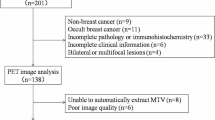Abstract
Background
The preoperative evaluation of axillary lymph node (LN) status is important for prognostic prediction of breast cancer. We investigated the ability of 18F-fluorodeoxyglucose positron emission tomography/computed tomography (18F-FDG PET/CT) to predict intratumoral lymphatic invasion and axillary LN metastasis.
Methods
The preoperative 18F-FDG PET/CT images and pathologic reports for 428 breast cancer patients between January 2003 and December 2008 were evaluated retrospectively. The maximum standardized uptake value (SUVmax) of the primary tumor on 18F-FDG PET/CT, the degree of lymphatic invasion, and axillary LN metastasis identified by pathologic reports were assessed. Univariate and multivariate logistic regression analyses were performed to identify the significant features of the primary tumor that were associated with pathologically confirmed axillary LN metastasis.
Results
The mean SUVmax of primary tumors with lymphatic invasion was higher than that of tumors without lymphatic invasion (5.13 ± 3.49 vs. 3.00 ± 2.47; p < 0.0001). The mean SUVmax of primary tumors with pathologically confirmed axillary LN metastasis was higher than that of tumors without LN metastasis (4.93 ± 3.32 vs. 3.22 ± 2.78; p < 0.0001). The degree of lymphatic invasion correlated strongly with axillary LN metastasis (p = 0.0001). Multiple logistic regression analysis showed that the high SUVmax of the primary tumor (>2.8), the high SUVmax of the axillary LN (>0.72) and the degree of lymphatic invasion were significant predictive factors of the development of axillary LN metastasis.
Conclusion
Breast cancer patients with higher primary tumor 18F-FDG uptake are at higher risk of concurrent intratumoral lymphatic invasion and axillary LN metastasis.
Similar content being viewed by others
References
Lauria R, Perrone F, Carlomagno C, De Laurentiis M, Morabito A, Gallo C, et al. The prognostic value of lymphatic and blood vessel invasion in operable breast cancer. Cancer. 1995;76:1772–8.
Chae BJ, Bae JS, Kang BJ, Kim SH, Jung SS, Song BJ. Positron emission tomography-computed tomography in the detection of axillary lymph node metastasis in patients with early stage breast cancer. Jpn J Clin Oncol. 2009;39:284–9.
Chung A, Liou D, Karlan S, Waxman A, Fujimoto K, Hagiike M, et al. Preoperative FDG-PET for axillary metastases in patients with breast cancer. Arch Surg. 2006;141:783–8 (discussion 8–9).
Heusner TA, Kuemmel S, Hahn S, Koeninger A, Otterbach F, Hamami ME, et al. Diagnostic value of full-dose FDG PET/CT for axillary lymph node staging in breast cancer patients. Eur J Nucl Med Mol Imaging. 2009;36:1543–50.
Amersi F, Hansen NM. The benefits and limitations of sentinel lymph node biopsy. Curr Treat Options Oncol. 2006;7:141–51.
Fehr MK, Hornung R, Varga Z, Burger D, Hess T, Haller U, et al. Axillary staging using positron emission tomography in breast cancer patients qualifying for sentinel lymph node biopsy. Breast J. 2004;10:89–93.
Lovrics PJ, Chen V, Coates G, Cornacchi SD, Goldsmith CH, Law C, et al. A prospective evaluation of positron emission tomography scanning, sentinel lymph node biopsy, and standard axillary dissection for axillary staging in patients with early stage breast cancer. Ann Surg Oncol. 2004;11:846–53.
van der Hoeven JJ, Hoekstra OS, Comans EF, Pijpers R, Boom RP, van Geldere D, et al. Determinants of diagnostic performance of [F-18] fluorodeoxyglucose positron emission tomography for axillary staging in breast cancer. Ann Surg. 2002;236:619–24.
Ueda S, Tsuda H, Asakawa H, Omata J, Fukatsu K, Kondo N, et al. Utility of 18F-fluoro-deoxyglucose emission tomography/computed tomography fusion imaging (18F-FDG PET/CT) in combination with ultrasonography for axillary staging in primary breast cancer. BMC Cancer. 2008;8:165.
Kurosumi M, Suemasu K, Tabei T, Inoue K, Matsumoto H, Sugamata N, et al. Relationship between existence of lymphatic invasion in peritumoral breast tissue and presence of axillary lymph node metastasis in invasive ductal carcinoma of the breast. Oncol Rep. 2001;8:1051–5.
Gajdos C, Tartter PI, Bleiweiss IJ. Lymphatic invasion, tumor size, and age are independent predictors of axillary lymph node metastases in women with T1 breast cancers. Ann Surg. 1999;230:692–6.
Zornoza G, Garcia-Velloso MJ, Sola J, Regueira FM, Pina L, Beorlegui C. 18F-FDG PET complemented with sentinel lymph node biopsy in the detection of axillary involvement in breast cancer. Eur J Surg Oncol. 2004;30:15–9.
Kim BS, Sung SH. Usefulness of 18F-FDG uptake with clinicopathologic and immunohistochemical prognostic factors in breast cancer. Ann Nucl Med. 2012;26:175–83.
Kim JY, Lee SH, Kim S, Kang T, Bae YT. Tumour 18 F-FDG Uptake on preoperative PET/CT may predict axillary lymph node metastasis in ER-positive/HER2-negative and HER2-positive breast cancer subtypes. Eur Radiol. 2015;25:1172–81.
Ikenaga N, Otomo N, Toyofuku A, Ueda Y, Toyoda K, Hayashi T, et al. Standardized uptake values for breast carcinomas assessed by fluorodeoxyglucose-positron emission tomography correlate with prognostic factors. Am Surg. 2007;73:1151–7.
Ekmekcioglu O, Aliyev A, Yilmaz S, Arslan E, Kaya R, Kocael P, et al. Correlation of 18F-fluorodeoxyglucose uptake with histopathological prognostic factors in breast carcinoma. Nucl Med Commun. 2013;34:1055–67.
Gil-Rendo A, Martinez-Regueira F, Zornoza G, Garcia-Velloso MJ, Beorlegui C, Rodriguez-Spiteri N. Association between [18F]fluorodeoxyglucose uptake and prognostic parameters in breast cancer. Br J Surg. 2009;96:166–70.
Groheux D, Giacchetti S, Moretti JL, Porcher R, Espie M, Lehmann-Che J, et al. Correlation of high 18F-FDG uptake to clinical, pathological and biological prognostic factors in breast cancer. Eur J Nucl Med Mol Imaging. 2011;38:426–35.
Author information
Authors and Affiliations
Corresponding author
Ethics declarations
Conflict of interest
The authors declare that they have no conflicts of interest.
About this article
Cite this article
Jung, N.Y., Kim, S.H., Kang, B.J. et al. The value of primary tumor 18F-FDG uptake on preoperative PET/CT for predicting intratumoral lymphatic invasion and axillary nodal metastasis. Breast Cancer 23, 712–717 (2016). https://doi.org/10.1007/s12282-015-0629-4
Received:
Accepted:
Published:
Issue Date:
DOI: https://doi.org/10.1007/s12282-015-0629-4




